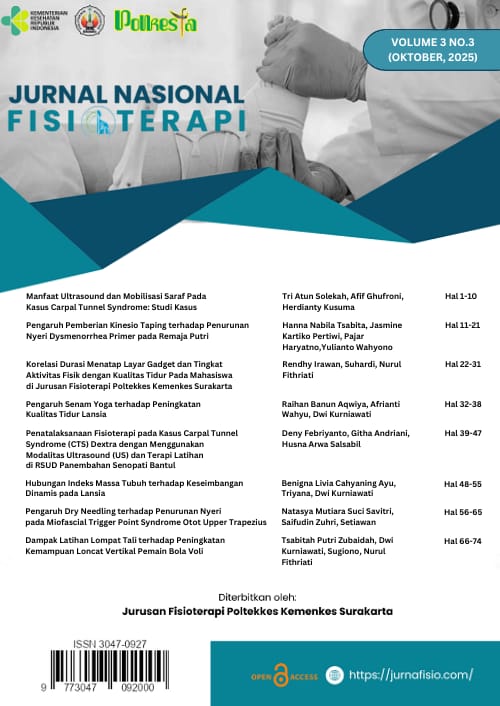KORELASI DURASI MENATAP LAYAR GADGET DAN TINGKAT AKTIVITAS FISIK DENGAN KUALITAS TIDUR PADA MAHASISWA DI JURUSAN FISIOTERAPI POLTEKKES KEMENKES SURAKARTA
DOI:
https://doi.org/10.64974/jnf.v3i3.89Keywords:
sleep quality, screen time, physical activity, PSQI, logistic regression, physiotherapy studentAbstract
Latar belakang: Kualitas tidur yang buruk berdampak pada sistem kardiovaskuler, neuromuskuler, dan muskuloskeletal. Mahasiswa fisioterapi berisiko mengalami gangguan tidur akibat stres, kurangnya aktivitas fisik, dan paparan layar gadget yang tinggi. Tujuan: Mengetahui hubungan antara durasi menatap layar gadget dan tingkat aktivitas fisik terhadap kualitas tidur mahasiswa fisioterapi Poltekkes Kemenkes Surakarta. Metode: Penelitian observasional analitik dengan pendekatan cross-sectional pada 87 mahasiswa. Kualitas tidur diukur menggunakan PSQI, aktivitas fisik diestimasi melalui VO₂max, dan durasi screen time dicatat per hari. Analisis
statistik menggunakan uji korelasi Spearman dan regresi logistik biner untuk mengevaluasi pengaruh gabungan variabel. Hasil: Terdapat hubungan signifikan antara aktivitas fisik dan kualitas tidur (r = +0,518; p < 0,01), tetapi tidak terdapat hubungan signifikan antara screen time dan kualitas tidur (r = -0,173; p = 0,132). Analisis regresi logistik menunjukkan bahwa aktivitas fisik secara signifikan memengaruhi kualitas tidur (OR = 8,556; 95% CI: 3,015–24,276; p < 0,001), sedangkan screen time tidak berpengaruh signifikan (OR = 0,584; 95% CI: 0,203–1,684; p = 0,320). Kesimpulan: Aktivitas fisik berhubungan positif terhadap kualitas tidur dan memiliki pengaruh
dominan dibandingkan durasi screen time. Saran: Intervensi untuk meningkatkan kualitas tidur pada mahasiswa sebaiknya fokus pada peningkatan aktivitas fisik, sementara manajemen screen time dapat dipertimbangkan sebagai pendukung.
Downloads
References
ACSM. (2021). ACSM's guidelines for exercise testing and prescription (11th ed.). Wolters Kluwer.
Alnawwar, M. A., Alraddadi, M. I., Algefhmi, R. A., Salem, G. A., Salem, M. A., & Alharbi, A. A. (2023). The effect of physical activity on sleep quality and sleep disorder: A systematic review. Cureus, 15(8), e43595. https://doi.org/10.7759/cureus.43595
Alshoaibi, Y., Bafil, W., & Rahim, M. (2023). The effect of screen use on sleep quality among adolescents in Riyadh, Saudi Arabia. Journal of Family Medicine and Primary Care, 12(7), 1379–1388. https://doi.org/10.4103/jfmpc.jfmpc_159_23
Buman, M. P., & King, A. C. (2010). Exercise as a treatment to enhance sleep. American Journal of Lifestyle Medicine, 4(6), 500–514. https://doi.org/10.1177/1559827610375532
Edelmann, D., Pfirrmann, D., Heller, S., Dietz, P., Reichel, J. L., Werner, A. M., ... & Kalo, K. (2022). Physical activity and sedentary behavior in university students—The role of gender, age, field of study, targeted degree, and study semester. Frontiers in Public Health, 10, 821703. https://doi.org/10.3389/fpubh.2022.821703
Fries, R. (2022). How to save your eyes in the digital age (2nd ed.). Eyesafe.
Hawkins, M. N., Raven, P. B., Snell, P. G., Stray-Gundersen, J., & Levine, B. D. (2007). Maximal oxygen uptake as a parametric measure of cardiorespiratory capacity. Medicine & Science in Sports & Exercise, 39(1), 103–107. https://doi.org/10.1249/01.mss.0000241641.75101.64
Kohl, H. W., Murray, T. D., & Salvo, D. (2020). Foundations of physical activity and public health (2nd ed.). Human Kinetics.
Kredlow, M. A., Capozzoli, M. C., Hearon, B. A., Calkins, A. W., & Otto, M. W. (2015). The effects of physical activity on sleep: A meta-analytic review. Journal of Behavioral Medicine, 38(3), 427–449. https://doi.org/10.1007/s10865-015-9617-6
Liguori, G. (2020). ACSM's resources for the exercise physiologist (3rd ed.). Wolters Kluwer.
Nakshine, V. S., Thute, P., Khatib, M. N., & Sarkar, B. (2022). Increased screen time as a cause of declining physical, psychological health, and sleep patterns: A literary review. Cureus, 14(10), e30051. https://doi.org/10.7759/cureus.30051
Nedea, D. (2020). VO₂ max calculator for aerobic capacity. MDApp. https://www.mdapp.co/vo2-max-calculator-for-aerobic-capacity-369/
Paillard, T. (2023). Detrimental effects of sleep deprivation on the regulatory mechanisms of postural balance: A comprehensive review. Frontiers in Human Neuroscience, 14, 1146550. https://doi.org/10.3389/fnhum.2023.1146550
Rafique, N., Al-Asoom, L. I., Alsunni, A. A., Saudagar, F. N., Almulhim, L., & Alkaltham, G. (2020). Effects of mobile use on subjective sleep quality. Nature and Science of Sleep, 12, 357–364. https://doi.org/10.2147/NSS.S253375
Rothman, K. J., Greenland, S., & Lash, T. L. (2008). Modern epidemiology (3rd ed.). Lippincott Williams & Wilkins.
Santos, R., Silva, A., Silva, R., Campos, M., Vieira, E., & do Prado, W. (2023). Relationship between free-time physical activity and sleep quality in Brazilian university students. Sleep Medicine Reviews, 58, 101490. https://doi.org/10.1016/j.smrv.2022.101700
Schmickler, J. M., Blaschke, S., Robbins, R., & Mess, F. (2023). Determinants of sleep quality: A cross-sectional study in university students. International Journal of Environmental Research and Public Health, 20(3), 2015. https://doi.org/10.3390/ijerph20032019
Wong, K. Y. (2012). A retinal ganglion cell that can signal irradiance continuously for 10 hours. Journal of Neuroscience, 32(33), 11478–11485. https://doi.org/10.1523/JNEUROSCI.1423-12.2012
Xu, F., Adams, S. K., Cohen, S. A., Earp, J. E., & Greaney, M. L. (2019). Relationship between physical activity, screen time, and sleep quantity and quality in US adolescents aged 16–19. International Journal of Environmental Research and Public Health, 16(9), 1524. https://doi.org/10.3390/ijerph16091524

Downloads
Published
How to Cite
Issue
Section
License
Copyright (c) 2025 Suhardi -, Rendhy Irawan, nurul fithriati haritsah

This work is licensed under a Creative Commons Attribution 4.0 International License.







